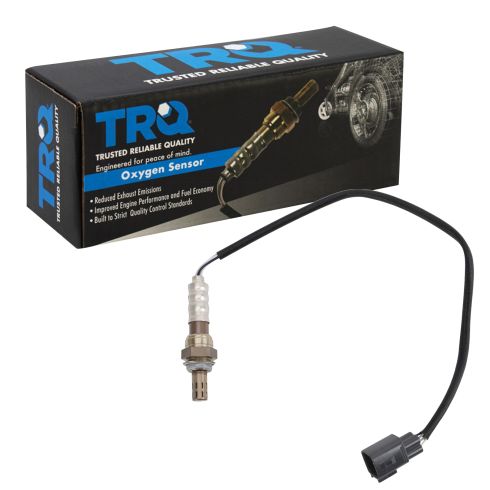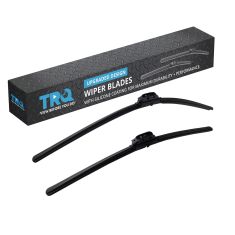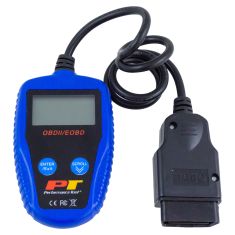Replaces
2020 Lexus RC300 L4 2.0L Downstream Bank 1 Sensor 2 O2 Oxygen Sensor TRQ OSA61176


OSA61176
This part doesn’t fit a . Select from parts that fit.
Specify your vehicle's year, make and model to guarantee fit.
This part doesn't fit a . Select from parts that fit.
Buy in the next and
Get it by: Wednesday, Dec 10 with expedited shipping
Recommended for your 2020 Lexus RC300
Frequently bought together
Specify your vehicle's year, make and model to guarantee fit.
This part doesn't fit a . Select from parts that fit.
Part Details
- 22 mm
- 0.87 in
- Specific
- 18 mm
- 0.71 in
- 4
- Male
- Blade
- 19.29 in
- 490 mm
- M18x1.5-6e
- Square
- Threaded
- Male
- Narrow-Band
- Yes
- Thimble
- 14.41 in
- 366 mm
- 4
- Standard Replacement
Specifications
- Downstream
- L4 2.0L
- Bank 1 Sensor 2
About TRQ:
TRQ is a trusted brand dedicated to making every repair a success story by combining premium parts with easy installation. Each TRQ part is engineered by a team of automotive experts to meet or exceed OEM standards, delivering enhanced performance and maximum longevity. With rigorous in-house testing, the brand ensures superior fit and function across every product line. TRQ also provides customers with best-in-class, step-by-step installation videos—so you can complete repairs with confidence, whether you're a first-time DIYer or an industry professional.
Product Features
- Application Specific Design: No modifications and pre-calibrated
- Isotatic-pressed and plasma-sprayed for extended service life
- Double-Layered 310S Stainless Steel: Additional protection from moisture and debris
- Restored Engine Performance: Improved fuel economy and lower emissions
TRQ oxygen sensors are manufactured to precise specifications using premium raw materials to optimize your vehicle’s emission system. Each sensor is isostatically-pressed for improved strength and durability, and plasma-sprayed to improve sensitivity and prolong the service life of the sensors. Oxygen sensors wear out over time and should be replaced every 60,000 miles to prevent poor engine performance. TRQ recommends replacing the oxygen sensors in sets to optimize fuel economy and reduce overall emissions. All products are fit and road-tested in our Massachusetts R&D facility to ensure we deliver on our promise of Trusted Reliable Quality.
What is Upstream vs. Downstream?
- Upstream location is between the catalytic converter and the engine
- Downstream location is between the catalytic converter and the tailpipe
Install Tip: You may be required to reset the vehicle computer after installation of this part.
Returns: Parts with electrical components cannot be returned once installed.
Attention California Customers:
![]() WARNING: This product can expose you to chemicals including Lead and Lead Compounds, which are known to the State of California to cause cancer, and birth defects or other reproductive harm. For more information, go to www.P65Warnings.ca.gov.
WARNING: This product can expose you to chemicals including Lead and Lead Compounds, which are known to the State of California to cause cancer, and birth defects or other reproductive harm. For more information, go to www.P65Warnings.ca.gov.
Lifetime Warranty
This item is backed by our limited lifetime warranty. In the event that this item should fail due to manufacturing defects during intended use, we will replace the part free of charge. This warranty covers the cost of the part only.
Returns: Parts with electrical components cannot be returned once installed.
FREE Shipping is standard on Orders shipped to the lower 48 States (Contiguous United States). Standard shipping charges apply to Hawaii, Alaska and US Territories. Shipping is not available to Canada.
Expedited is available on checkout to the United States, excluding Alaska, Hawaii and US Territories as well as P.O. Boxes and APO/FPO/DPO addresses. Final shipping costs are available at checkout.



Created on:
Tools used
- Raise and support the vehicle with a jack and jack stands Remove the 10mm bolts from the splash shield Remove the four body clips from the splash shields with a trim tool Remove the splash shields
- Disconnect the O2 sensor's gray electrical connector with a pair of pliers Remove the sensor wire from the bracket Loosen the downstream O2 sensor with a 22mm or oxygen sensor socket and ratchet Twist off and remove the downstream oxygen sensor
- Inspect the threads in the exhaust pipe for stripping Feel the threads grab and turn the oxygen sensor into the exhaust by hand Tighten the O2 sensor with a 22mm or oxygen sensor socket and ratchet Thread the sensor wire through the bracket Connect the sensor connector Reroute the excess wire by looping in the bracket it without pinching it
- Insert the splash shield into place (R for passenger side and L for driver side) Tighten the 10mm bolts to the splash shield Press in the four body clips
Hey, everyone. Sue here from 1A Auto. Today we have our 2013 Camry in the shop. It's got the V6 3.5 liter in it. I'm going to show you how to remove and replace the downstream O2 sensor. That would be bank one, sensor two. If you need that part or any other part for your car, click on the link below and head on over to 1AAuto.com.
To take the undercarriage shield down, we're going to need a 10-millimeter socket and a body clip tool. This car has had the shield down, somebody replaced. For the most part, it should be a 10-millimeter socket, but this one someone put in, they are actually standard 13 or 1/2 sockets. I'm just going to take them down. Switch over to the 10. You're going to do the same per side. There's three bolts with that little rubber vent. It just directs the airflow. You can take those down, and then you're going to have one, two, three, four across the front, and then one body clip.
Now I'm going to do the body clip. There's the R for right side/passenger side and the L for left side/driver side. Now we're going to replace the downstream O2 sensor on our '13 Camry with the 3.5 liter--that's the V6. We're doing the downstream bank one. If you were to look it up, someone could call it bank one downstream or B1S2. S2 means sensor two. The downstreams are always considered the sensor two, not as in also, but as in the number two. You have your one bank, and you have bank two--bank one and bank two. We're going to be working on bank one downstream O2 sensor. This one is nice and easy--it's out in the open.
What I do is you get a black clip and a gray clip. Once I identified which one I'm going to be replacing, that's going to be the gray clip on this bracket. I'm going to push down on this tab here. I like to use a pair of pliers. Sometimes I just can't get it to pull, so I just grab it lightly and pull that out. Toyota. This Toyota has an actual middle bracket. It holds the wires in place, so that way it stops it from hitting the exhaust while you get on the road. Now I just have to fish that out of that bracket. Bring that sensor and bring the wire down. Then there is the sensor itself in the exhaust pipe. That's going to be a 22-millimeter or a oxygen sensor socket.
I'm going to use an oxygen sensor socket, and that's a specialty socket that is opened up almost like a crow's foot or a tubing wrench crow's foot. You slide that down over the harness. Settle down on that right where the octagon, hectagon is, and then you're just going to give it a quick tug and break it free. If yours is really in there, it's hard to get, you can use a little MAPP gas and heat it up. That's it, you're at home. If you're a home owner. You should have a little can of MAPP gas for if you do soldering or a little plumbing. If not, you can get one at a hardware store pretty cheap. You just want to heat up this section of it and then break it free.
Here we have our new O2 sensor from 1A Auto. Here we have the factory O2 sensor on our '13 Camry 3.5-liter of the new one. We'll have a little bit longer length to it. That's very common with aftermarket O2 sensors. They just want to give you a little bit more just to make sure. It's better to have more than less because if it's not going to reach, it's not going to work. O2 sensor, the new one comes with this protective cover because it has a little thread lock or NECs on the actual threads, so you don't want to get that everywhere. You can look real quick and see that they're the same depth. They have the same cutout. They have cutouts. That's where the oxygen sensors show. You say it takes a sniff and does the reading. The most important part is down here. You'll see that the connectors match. That's what you're looking for. You want to make sure those connectors match and will work. You don't want to get through this job and find out that the connector doesn't fit in there.
Before you always start an O2 sensor, I strongly recommend matching up this end connector before you take it out. If you need this part or any other part for your car, click on the link below and head on over to 1AAuto.com. Before I put my O2 sensor in the new one, our new one came out pretty smooth. If you have one that's really rough coming out, take a good look at the threads here. Make sure there's threads still in the exhaust pipe because I've seen them stripped out completely, just in case you weren't the last one in there. These look pretty good, and you'll be able to feel it as you start this new one. You want to feel the threads grab. Fall right into place, basically. You should have no problem doing that by hand. If it gets really rough, they do make a tap for oxygen sensors, a specific one, size and everything. Hopefully, you don't need to purchase that for a one-time deal, but you want those threads to be cleaned up. Make sure that those goes in there nice and tight.
I'm just going to get my socket and reverse the direction. It has a crush washer on it, so even though you think it's tight, it just keeps going. Just like a spark plug, so you want to bottom it out. Once it bottoms out on that crush washer, you're going to give it another little quarter of a turn to an eighth of a turn. That's the washer is now crushed. Perfect. I'm going to take my wire, and I'm going to feed it up through here. I'm going to put it in that bracket. Make sure it pinches in that connector because I don't want it resting against my exhaust. I'm going to look at my connector and see that's the way the tab is, the lock tab. Guide it in that way, and then click it together.
Now with the excess type of wire, I want to make sure I route that so I know I have a plastic shield, but the shield only comes to here. I'm not going to be wanting this wire hanging down like that. I'm going to see if I can double it up in a loop. I don't want to pinch the wires, so this is where it becomes a little tricky. Try to do your best without damaging the actual wire. I'm just rerouting it back past this bracket that this manufacturer actually supplies, and then put it into the actual, it's almost like a paperclip. I guess that's what I would say, the design that they did. I just basically looped it, so that the excess is up inside there. My wire is not hanging down, nothing is going to catch it, and it's not up hitting on the convertor. That looks pretty good.
When I put the shield back up I've got the R for right side, which would be the passenger side. You can see the cutout of the fender well right here. I'm going to guide it in. You want the tab from the bumper underneath, and you want to put all these little flares up under like that. I'm going to put one bolt in and hold it. Then I'm going to go over here. I've got my fender guide here, so that's going to go on top there, then that one. This has that rubber piece, remember. I'm going to get my electric gun with my 10-millimeter socket. I'm going to do the same on the driver's side, which is the plastic that says L. That's going to go overlap up inside. The one piece I put on, the one bolt I tighten up, of course, like that up inside the fender flare. There we go.
Now I can take my rubber piece here. I'm going to flip that up, make sure I line that up. Okay, up in the front here. Get this one. You got this one that overlaps. This piece has got to go down underneath it. Then we have a push pin that I'm going to put in right here. Then the last one is a replacement push pin.
Thanks for watching. Visit 1AAuto.com for quality auto parts shipped to your door, the place for DIY auto repair. If you enjoyed this video, please click the subscribe button.
Tools used
- Upstream oxygen sensors are located in between the engine and the catalytic converter Downstream oxygen sensors are located in the catalytic converter or farther away from the engine than the catalytic converter Locate your vehicle's firing order diagram The bank that contains cylinder one is bank one The bank that does not contain cylinder one is bank two, even if it does not contain cylinder two
Hi, I'm Mike from 1A Auto. We've been selling auto parts for over 30 years. We're dedicated to delivering quality auto parts, expert customer service, fast and free shipping, all backed by our 100% satisfaction guarantee. Visit us at 1AAuto.com, your trusted source for quality auto parts.
In this video I have a couple of oxygen sensors with me. While there are some aesthetic differences here, the wire lengths are a little different, the actual body and tip of the sensor are a little different, the threads and gasket are the same, and on the other end the connections are actually the same. I can plug these into either position on our vehicle. But if I had to ask you which one's upstream and which one's downstream, you probably can't tell just from looking at them. That's true of most oxygen sensors. The way you determine whether or not an O2 sensor is upstream or downstream is all done visually.
Your oxygen sensor position can be determined relative to your catalytic convertor. As the name suggests, upstream sensors will be located upstream or ahead of, in front of, above, closer to the engine than your catalytic convertors. This means that they see the exhaust gasses first. They then go through the catalytic convertor and to the downstream oxygen sensor, which will either be located in the catalytic convertor like our vehicle here, or after the catalytic convertor to monitor the gasses coming out of the cat and make sure that it's being efficient relative to the readings of the upstream O2 sensor.
The other determination you need to make is bank one versus bank two. Determining which bank is which can be done by looking at a picture of your vehicle's firing order. Whichever bank contains cylinder one is going to be bank one, and the other one, regardless of whether or not cylinder two is in it, is going to be bank two by default. These banks are true of V engines like V8s, V6s, and flat engines like Porsches and Subarus that have individual banks.
On inline four-cylinder engines, as long as they have one exhaust manifold like a Jeep four-liter or a four-cylinder Honda engine, you'll only have one bank with an upstream and downstream O2 sensor. There will be no bank two on the engine.
On our vehicle here, this is the passenger side, which we've already determined from the firing order is bank one. We have our upstream sensor here closest to the engine ahead of the cat. Then we have our downstream or sensor two here inside of the catalytic convertor. This could also be located somewhere after the cat. Here I have my two sensors for the vehicle. While they are aesthetically different, we can now tell this is my upstream sensor because it looks just like the upstream sensor I have up there. This is my downstream sensor. Now that we know which one's which, we can order the right part, correct the problem, and fix you up right.
Thanks for watching. Visit us at 1AAuto.com for quality auto parts, fast and free shipping, and the best customer service in the industry.
OSA61176
877-844-3393
Monday - Friday 8:00am - 9:30pm ET
Saturday - Sunday 8:00am - 4:30pm ET
Specify your vehicle's year, make and model to guarantee fit.
This part doesn't fit a . Select from parts that fit.







